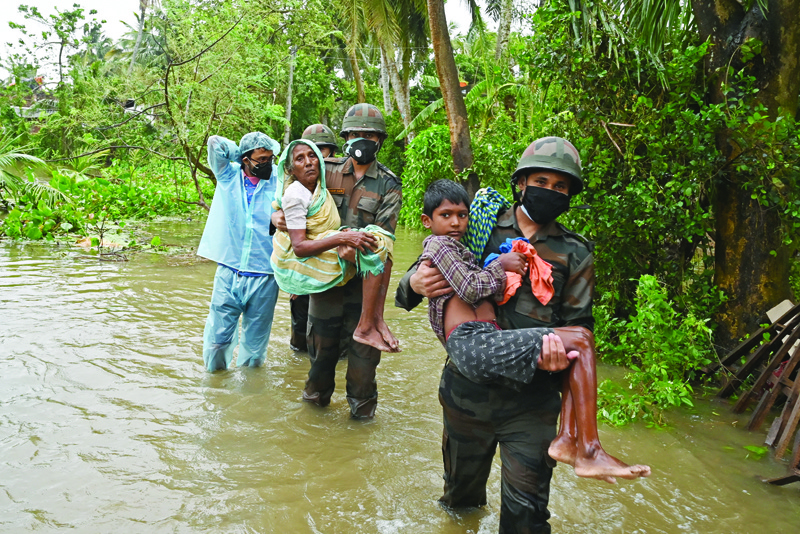 DIGHA, India: Indian army personnel wades through the flooded village roads carrying people to safety as Cyclone Yaas barrels towards India's eastern coast in the Bay of Bengal. — AFP
DIGHA, India: Indian army personnel wades through the flooded village roads carrying people to safety as Cyclone Yaas barrels towards India's eastern coast in the Bay of Bengal. — AFP
DIGHA, India: At least three people died yesterday as howling winds and waves the height of double-decker buses belted eastern India in the COVID-stricken country's second cyclone in as many weeks. Cyclones are a regular menace in the northern Indian Ocean but many scientists say they are becoming more frequent and severe as climate change warms the waters of the Bay of Bengal and Arabian Sea. Barely a week after Cyclone Tauktae claimed at least 155 lives in western India, Cyclone Yaas has forced the evacuation of more than 1.5 million people in the eastern states of West Bengal and Odisha.
West Bengal chief minister Mamata Banerjee said that the seaside town of Digha had been "swamped" by waves up to four meters (13 feet) high. She said two people had been killed, including one dragged into the sea by the waves in Digha and another crushed when his house collapsed. The storm packed lashing rain and winds gusting up to 155 kilometers (95 miles) an hour, the equivalent to a category-two hurricane.
"I have never seen such a storm ever in my life," said Purnendu Jana, a Digha resident. "The water may cross the main road for the first time." Local hotel owner Shiuli Das said: "Many of us are here, all of us are really scared." Nearly 20,000 houses were damaged and more than a dozen river islands were flooded with a number of embankments breached, Banerjee said. In Odisha there was also extensive damage with hundreds of trees uprooted although there was minimal damage to power infrastructure, relief official Pradeep Kumar Jena said. "We have received reports regarding the death of two people... Local officials are investigating the two incidents," Jena said.
In neighboring Bangladesh one man was killed by a falling tree as the waves smashed through water defenses and inundated thousands of homes, officials told AFP. Locals feared the situation would worsen in the evening as the tide rises to a higher level than normal because of a full moon. "My house is already submerged under four feet of water. I don't know what will happen during the full moon tonight," Mostak Ahmed told AFP by phone from Khulna, in the country's south.
'Terrible blow'
Almost 5,000 disaster workers were deployed in India with tree and wire cutters, emergency communications, inflatable boats and medical aid, the National Disaster Response Force said. Officials fear the emergency will further complicate efforts to halt a surge in coronavirus cases that has now killed 310,000 people.
Masks were distributed in emergency shelters but West Bengal state minister Bankim Chandra Hazra told AFP that maintaining social distancing would be "a big challenge". "This cyclone spells double trouble for millions of people in India as there is no respite from COVID-19," said Udaya Regmi from the International Federation of Red Cross and Red Crescent Societies.
Some vaccination centres in threatened districts, as well as Kolkata, suspended operations and a special effort had been launched to ensure the supply of oxygen and medicines to hospitals, officials said. Some of the deadliest storms in history have formed in the Bay of Bengal, including one in 1970 that killed half a million people in what is now Bangladesh. Odisha's worst-ever cyclone, in 1999, killed 10,000 people. Last year Cyclone Amphan, the worst since then, caused widespread devastation but timely evacuations meant fatalities were fewer than 150. - AFP

